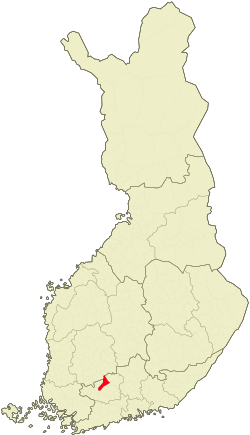Hattula
Hattula is a municipality of Finland. Its seat is in Parola.
Hattula | |
|---|---|
Municipality | |
| Hattulan kunta Hattula kommun | |
 Coat of arms | |
 Location of Hattula in Finland | |
| Coordinates: 61°03′N 024°22′E | |
| Country | |
| Region | Tavastia Proper |
| Sub-region | Hämeenlinna sub-region |
| Charter | 1868 |
| Seat | Parola |
| Government | |
| • Municipal manager | Katariina Koivisto |
| Area (2018-01-01)[1] | |
| • Total | 427.39 km2 (165.02 sq mi) |
| • Land | 357.84 km2 (138.16 sq mi) |
| • Water | 69.55 km2 (26.85 sq mi) |
| Area rank | 214th largest in Finland |
| Population (2019-01-31)[2] | |
| • Total | 9,489 |
| • Rank | 105th largest in Finland |
| • Density | 26.52/km2 (68.7/sq mi) |
| Population by native language | |
| • Finnish | 98.9% (official) |
| • Swedish | 0.4% |
| • Others | 0.7% |
| Population by age | |
| • 0 to 14 | 19% |
| • 15 to 64 | 65.8% |
| • 65 or older | 15.2% |
| Time zone | UTC+02:00 (EET) |
| • Summer (DST) | UTC+03:00 (EEST) |
| Municipal tax rate[5] | 19.25% |
| Website | www.hattula.fi |
It is part of the Tavastia Proper region and until 2010 it was located in the province of Southern Finland. The municipality has a population of 9,489 (31 January 2019)[2] and covers an area of 427.39 square kilometres (165.02 sq mi) of which 69.55 km2 (26.85 sq mi) is water.[1] The population density is 26.52 inhabitants per square kilometre (68.7/sq mi).
The municipality is unilingually Finnish.
A central element of the landscape in Hattula is lake Vanajavesi by which most of the oldest settlements in the area are concentrated. A notable monument is the Holy Cross Church in Hattula.
The main attractions of Hattula are based on the long history of the municipality as a church pilgrimage site and the location of the Parolannummi garrison. The Army Brigade operates in the Parola garrison. Also close to the garrison are the Armored Museum presenting the history of the Armored and Anti-Army troops and the Paragon Lion sculpture by Andreas Fornander. The Lion of Parola is a statue of a lion holding a ball in his paw, commemorating the visit of Emperor Alexander II of Russia to Parolannummi on July 29, 1863. The same theme is repeated in the Armor School flag. A monument of more than five meters is located on the southern edge of the garrison training ground.
There are three Evangelical Lutheran churches in the municipality: the medieval Church of the Holy Cross, the new Hattula church built in the 1850s and the Tyrväntö church built in the late 18th and 18th centuries in Suotala. In addition to these, the Pentecostal Church's Home Church also operates in the center of the municipality.
The long manor culture in Hattula is represented by the manors of Ahlbacka, Ellilä, Metsänkylä, Lepaa,[6] Lahdenta, Suontaa and Vesunni. In addition to the Iron Age Tenholan Castle Mountain, earlier settlement in the area is also evidenced by numerous archaeological finds. The historic Häme Härkätie (connecting road 2855) also passes the track in the Hattula area in the villages of Kivijoki and Kouvala.
Astronomer Anders Planman was born in Hattula. He was one of the first persons to make systematical astronomical observations in Finland.
References
- "Area of Finnish Municipalities 1.1.2018" (PDF). National Land Survey of Finland. Retrieved 30 January 2018.
- "Suomen virallinen tilasto (SVT): Väestön ennakkotilasto [verkkojulkaisu]. Tammikuu 2019" (in Finnish). Statistics Finland. Retrieved 15 March 2019.
- "Population according to language and the number of foreigners and land area km2 by area as of 31 December 2008". Statistics Finland's PX-Web databases. Statistics Finland. Retrieved 29 March 2009.
- "Population according to age and gender by area as of 31 December 2008". Statistics Finland's PX-Web databases. Statistics Finland. Retrieved 28 April 2009.
- "List of municipal and parish tax rates in 2011". Tax Administration of Finland. 29 November 2010. Retrieved 13 March 2011.
- "Lepaan puutarhaopisto toimii keskiaikaisessa kartanossa", Kansanuutiset 7 August 2013. Retrieved 18 December 2019
External links
- Municipality of Hattula – Official website
| Wikimedia Commons has media related to Hattula. |
